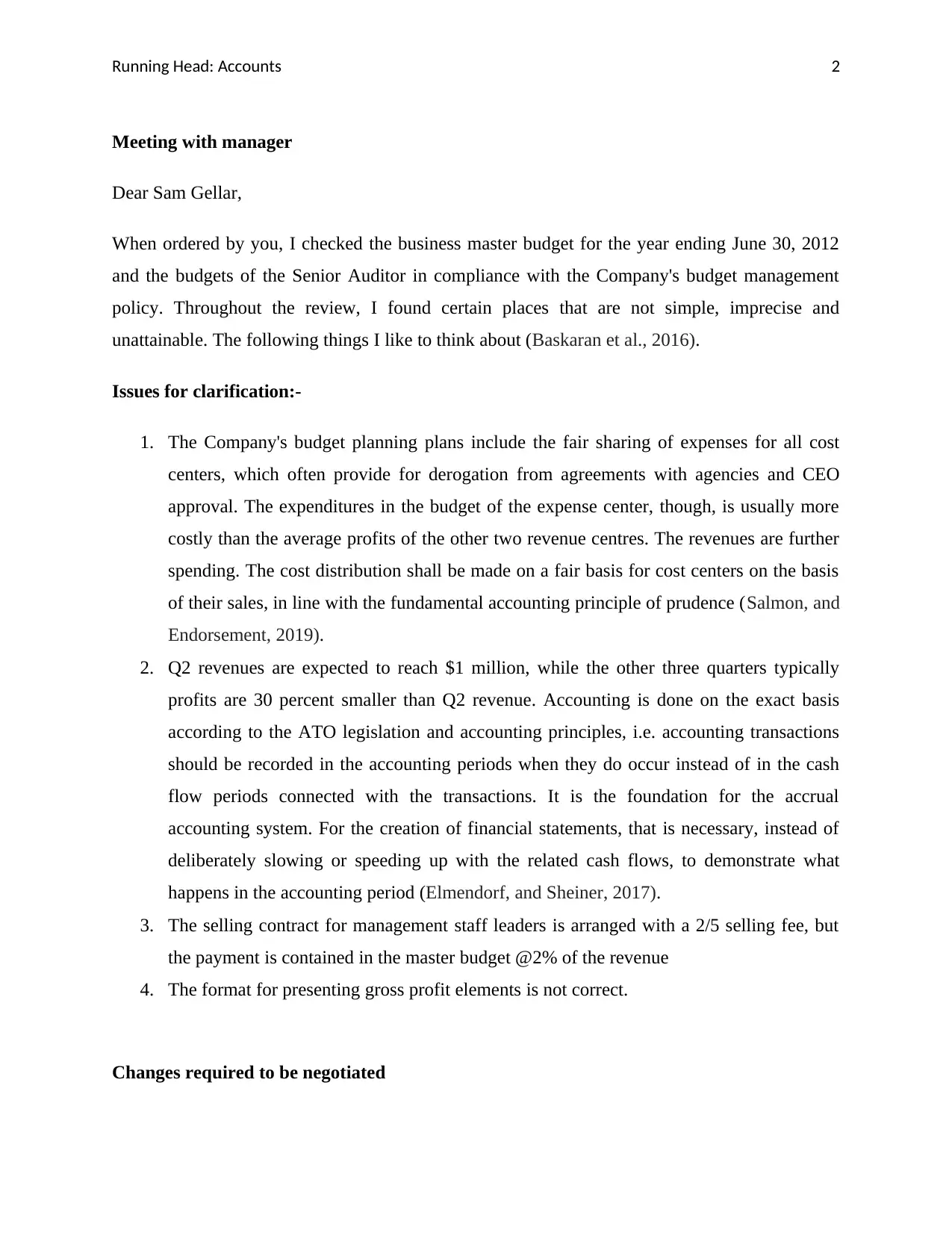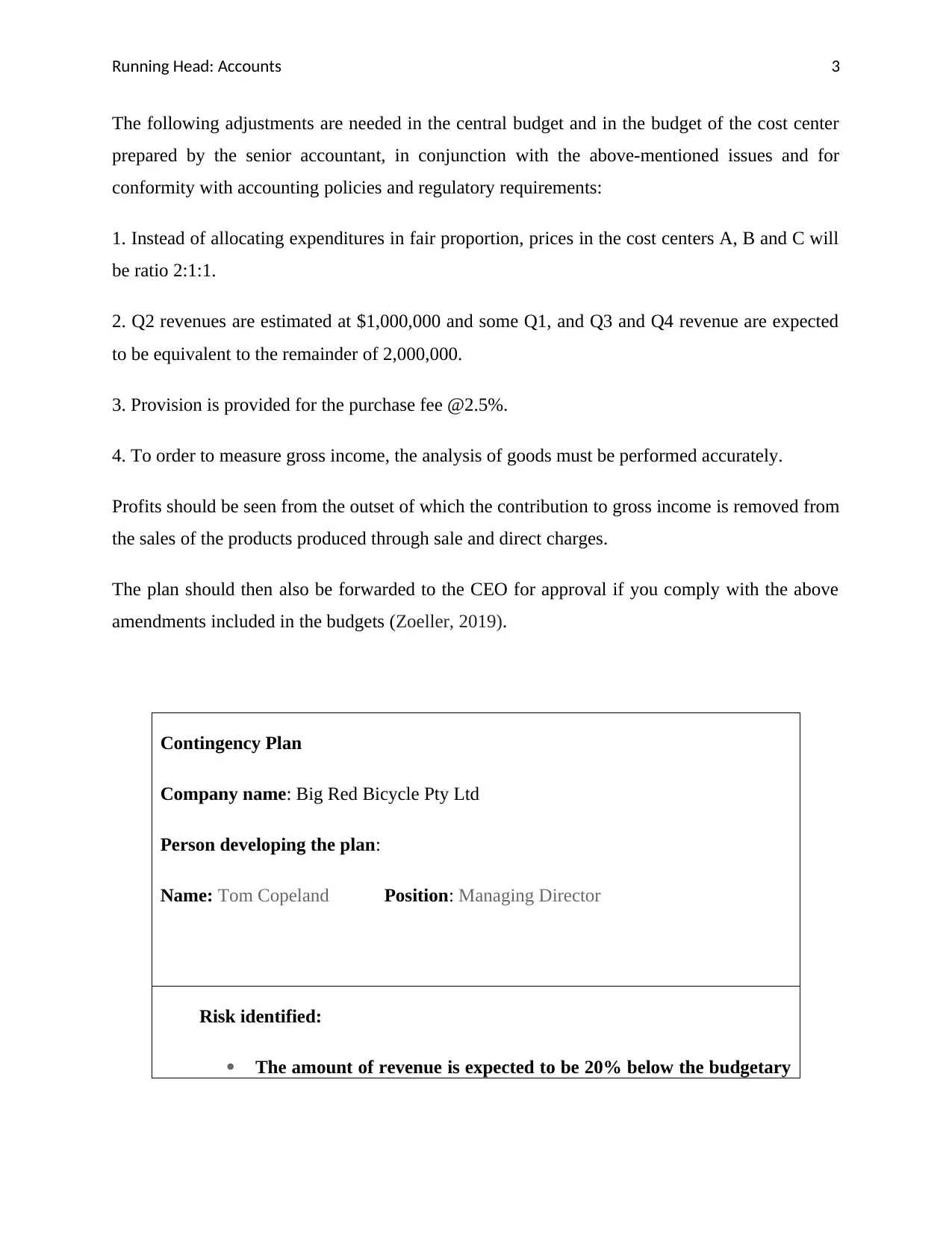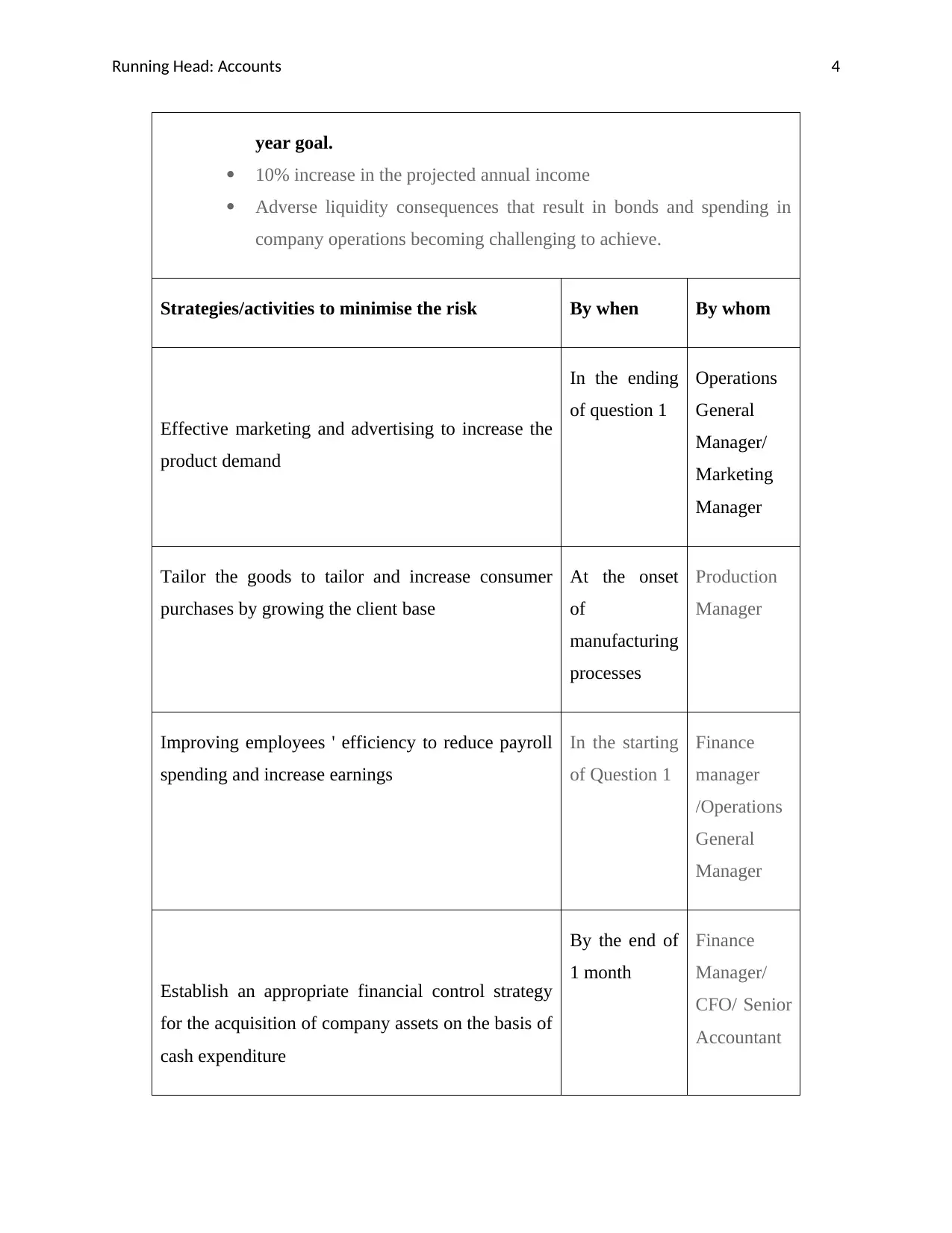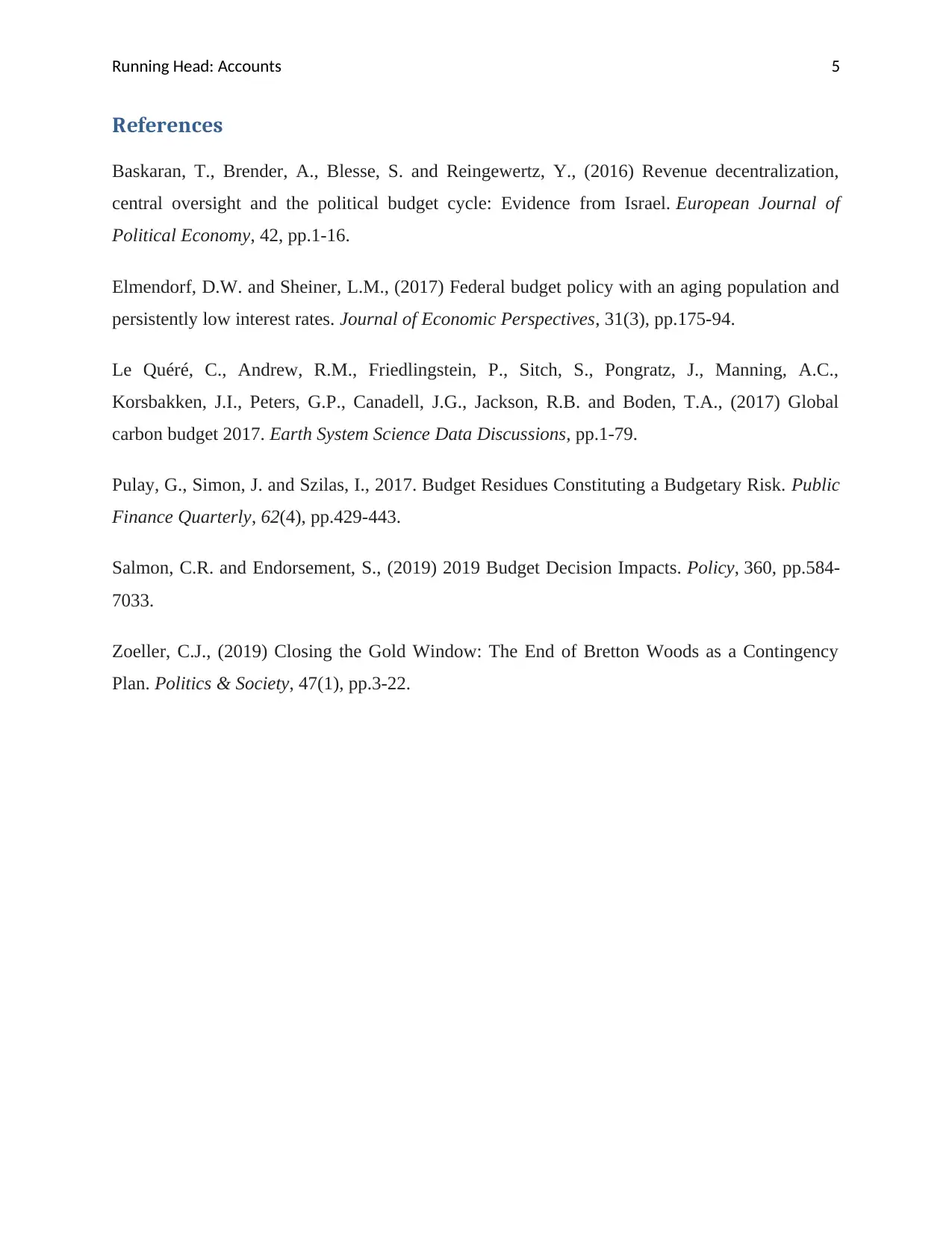Comprehensive Financial Analysis and Report: Big Red Bicycle
VerifiedAdded on 2022/08/24
|5
|943
|21
Report
AI Summary
This report, prepared by the Sales Manager, analyzes the accounts of Big Red Bicycle Pty Ltd, focusing on the master budget for the year ending June 30, 2012. It identifies several issues, including unfair expense allocation, inaccurate revenue projections, and discrepancies in the sales commission structure. The report recommends adjustments to the budget, such as reallocating expenses based on a 2:1:1 ratio for cost centers, correcting revenue forecasts, and applying the correct sales commission rate. A contingency plan is also developed to mitigate the risk of revenue falling below the budgetary goal, outlining strategies to increase product demand, tailor products, improve employee efficiency, and establish financial controls. The report adheres to accounting principles and regulatory requirements and includes references to relevant financial literature.

Running Head: Accounts 1
Account
Student Name
3/20/2020
Account
Student Name
3/20/2020
Paraphrase This Document
Need a fresh take? Get an instant paraphrase of this document with our AI Paraphraser

Running Head: Accounts 2
Meeting with manager
Dear Sam Gellar,
When ordered by you, I checked the business master budget for the year ending June 30, 2012
and the budgets of the Senior Auditor in compliance with the Company's budget management
policy. Throughout the review, I found certain places that are not simple, imprecise and
unattainable. The following things I like to think about (Baskaran et al., 2016).
Issues for clarification:-
1. The Company's budget planning plans include the fair sharing of expenses for all cost
centers, which often provide for derogation from agreements with agencies and CEO
approval. The expenditures in the budget of the expense center, though, is usually more
costly than the average profits of the other two revenue centres. The revenues are further
spending. The cost distribution shall be made on a fair basis for cost centers on the basis
of their sales, in line with the fundamental accounting principle of prudence (Salmon, and
Endorsement, 2019).
2. Q2 revenues are expected to reach $1 million, while the other three quarters typically
profits are 30 percent smaller than Q2 revenue. Accounting is done on the exact basis
according to the ATO legislation and accounting principles, i.e. accounting transactions
should be recorded in the accounting periods when they do occur instead of in the cash
flow periods connected with the transactions. It is the foundation for the accrual
accounting system. For the creation of financial statements, that is necessary, instead of
deliberately slowing or speeding up with the related cash flows, to demonstrate what
happens in the accounting period (Elmendorf, and Sheiner, 2017).
3. The selling contract for management staff leaders is arranged with a 2/5 selling fee, but
the payment is contained in the master budget @2% of the revenue
4. The format for presenting gross profit elements is not correct.
Changes required to be negotiated
Meeting with manager
Dear Sam Gellar,
When ordered by you, I checked the business master budget for the year ending June 30, 2012
and the budgets of the Senior Auditor in compliance with the Company's budget management
policy. Throughout the review, I found certain places that are not simple, imprecise and
unattainable. The following things I like to think about (Baskaran et al., 2016).
Issues for clarification:-
1. The Company's budget planning plans include the fair sharing of expenses for all cost
centers, which often provide for derogation from agreements with agencies and CEO
approval. The expenditures in the budget of the expense center, though, is usually more
costly than the average profits of the other two revenue centres. The revenues are further
spending. The cost distribution shall be made on a fair basis for cost centers on the basis
of their sales, in line with the fundamental accounting principle of prudence (Salmon, and
Endorsement, 2019).
2. Q2 revenues are expected to reach $1 million, while the other three quarters typically
profits are 30 percent smaller than Q2 revenue. Accounting is done on the exact basis
according to the ATO legislation and accounting principles, i.e. accounting transactions
should be recorded in the accounting periods when they do occur instead of in the cash
flow periods connected with the transactions. It is the foundation for the accrual
accounting system. For the creation of financial statements, that is necessary, instead of
deliberately slowing or speeding up with the related cash flows, to demonstrate what
happens in the accounting period (Elmendorf, and Sheiner, 2017).
3. The selling contract for management staff leaders is arranged with a 2/5 selling fee, but
the payment is contained in the master budget @2% of the revenue
4. The format for presenting gross profit elements is not correct.
Changes required to be negotiated

Running Head: Accounts 3
The following adjustments are needed in the central budget and in the budget of the cost center
prepared by the senior accountant, in conjunction with the above-mentioned issues and for
conformity with accounting policies and regulatory requirements:
1. Instead of allocating expenditures in fair proportion, prices in the cost centers A, B and C will
be ratio 2:1:1.
2. Q2 revenues are estimated at $1,000,000 and some Q1, and Q3 and Q4 revenue are expected
to be equivalent to the remainder of 2,000,000.
3. Provision is provided for the purchase fee @2.5%.
4. To order to measure gross income, the analysis of goods must be performed accurately.
Profits should be seen from the outset of which the contribution to gross income is removed from
the sales of the products produced through sale and direct charges.
The plan should then also be forwarded to the CEO for approval if you comply with the above
amendments included in the budgets (Zoeller, 2019).
Contingency Plan
Company name: Big Red Bicycle Pty Ltd
Person developing the plan:
Name: Tom Copeland Position: Managing Director
Risk identified:
The amount of revenue is expected to be 20% below the budgetary
The following adjustments are needed in the central budget and in the budget of the cost center
prepared by the senior accountant, in conjunction with the above-mentioned issues and for
conformity with accounting policies and regulatory requirements:
1. Instead of allocating expenditures in fair proportion, prices in the cost centers A, B and C will
be ratio 2:1:1.
2. Q2 revenues are estimated at $1,000,000 and some Q1, and Q3 and Q4 revenue are expected
to be equivalent to the remainder of 2,000,000.
3. Provision is provided for the purchase fee @2.5%.
4. To order to measure gross income, the analysis of goods must be performed accurately.
Profits should be seen from the outset of which the contribution to gross income is removed from
the sales of the products produced through sale and direct charges.
The plan should then also be forwarded to the CEO for approval if you comply with the above
amendments included in the budgets (Zoeller, 2019).
Contingency Plan
Company name: Big Red Bicycle Pty Ltd
Person developing the plan:
Name: Tom Copeland Position: Managing Director
Risk identified:
The amount of revenue is expected to be 20% below the budgetary
⊘ This is a preview!⊘
Do you want full access?
Subscribe today to unlock all pages.

Trusted by 1+ million students worldwide

Running Head: Accounts 4
year goal.
10% increase in the projected annual income
Adverse liquidity consequences that result in bonds and spending in
company operations becoming challenging to achieve.
Strategies/activities to minimise the risk By when By whom
Effective marketing and advertising to increase the
product demand
In the ending
of question 1
Operations
General
Manager/
Marketing
Manager
Tailor the goods to tailor and increase consumer
purchases by growing the client base
At the onset
of
manufacturing
processes
Production
Manager
Improving employees ' efficiency to reduce payroll
spending and increase earnings
In the starting
of Question 1
Finance
manager
/Operations
General
Manager
Establish an appropriate financial control strategy
for the acquisition of company assets on the basis of
cash expenditure
By the end of
1 month
Finance
Manager/
CFO/ Senior
Accountant
year goal.
10% increase in the projected annual income
Adverse liquidity consequences that result in bonds and spending in
company operations becoming challenging to achieve.
Strategies/activities to minimise the risk By when By whom
Effective marketing and advertising to increase the
product demand
In the ending
of question 1
Operations
General
Manager/
Marketing
Manager
Tailor the goods to tailor and increase consumer
purchases by growing the client base
At the onset
of
manufacturing
processes
Production
Manager
Improving employees ' efficiency to reduce payroll
spending and increase earnings
In the starting
of Question 1
Finance
manager
/Operations
General
Manager
Establish an appropriate financial control strategy
for the acquisition of company assets on the basis of
cash expenditure
By the end of
1 month
Finance
Manager/
CFO/ Senior
Accountant
Paraphrase This Document
Need a fresh take? Get an instant paraphrase of this document with our AI Paraphraser

Running Head: Accounts 5
References
Baskaran, T., Brender, A., Blesse, S. and Reingewertz, Y., (2016) Revenue decentralization,
central oversight and the political budget cycle: Evidence from Israel. European Journal of
Political Economy, 42, pp.1-16.
Elmendorf, D.W. and Sheiner, L.M., (2017) Federal budget policy with an aging population and
persistently low interest rates. Journal of Economic Perspectives, 31(3), pp.175-94.
Le Quéré, C., Andrew, R.M., Friedlingstein, P., Sitch, S., Pongratz, J., Manning, A.C.,
Korsbakken, J.I., Peters, G.P., Canadell, J.G., Jackson, R.B. and Boden, T.A., (2017) Global
carbon budget 2017. Earth System Science Data Discussions, pp.1-79.
Pulay, G., Simon, J. and Szilas, I., 2017. Budget Residues Constituting a Budgetary Risk. Public
Finance Quarterly, 62(4), pp.429-443.
Salmon, C.R. and Endorsement, S., (2019) 2019 Budget Decision Impacts. Policy, 360, pp.584-
7033.
Zoeller, C.J., (2019) Closing the Gold Window: The End of Bretton Woods as a Contingency
Plan. Politics & Society, 47(1), pp.3-22.
References
Baskaran, T., Brender, A., Blesse, S. and Reingewertz, Y., (2016) Revenue decentralization,
central oversight and the political budget cycle: Evidence from Israel. European Journal of
Political Economy, 42, pp.1-16.
Elmendorf, D.W. and Sheiner, L.M., (2017) Federal budget policy with an aging population and
persistently low interest rates. Journal of Economic Perspectives, 31(3), pp.175-94.
Le Quéré, C., Andrew, R.M., Friedlingstein, P., Sitch, S., Pongratz, J., Manning, A.C.,
Korsbakken, J.I., Peters, G.P., Canadell, J.G., Jackson, R.B. and Boden, T.A., (2017) Global
carbon budget 2017. Earth System Science Data Discussions, pp.1-79.
Pulay, G., Simon, J. and Szilas, I., 2017. Budget Residues Constituting a Budgetary Risk. Public
Finance Quarterly, 62(4), pp.429-443.
Salmon, C.R. and Endorsement, S., (2019) 2019 Budget Decision Impacts. Policy, 360, pp.584-
7033.
Zoeller, C.J., (2019) Closing the Gold Window: The End of Bretton Woods as a Contingency
Plan. Politics & Society, 47(1), pp.3-22.
1 out of 5
Related Documents
Your All-in-One AI-Powered Toolkit for Academic Success.
+13062052269
info@desklib.com
Available 24*7 on WhatsApp / Email
![[object Object]](/_next/static/media/star-bottom.7253800d.svg)
Unlock your academic potential
Copyright © 2020–2025 A2Z Services. All Rights Reserved. Developed and managed by ZUCOL.





